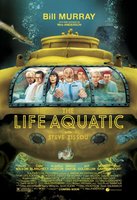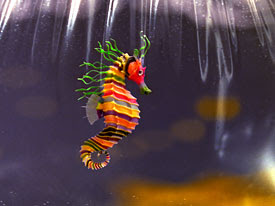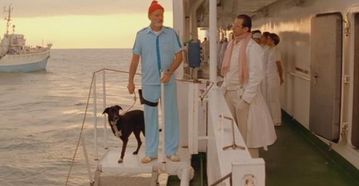
Wes Anderson’s fourth full-length film, The Life Aquatic with Steve Zissou, details the life of oceanographer and documentarian Steve Zissou following the death of his professional partner and best friend. The film, like many directed by Wes Anderson, ultimately became a cult classic, but not before being met with serious criticism from film critics. The dissonance between the critics and the general audience is obvious on Rotten Tomatoes, where the film has a rating of 56% from critics compared to the 83% audience rating [1]. Critics complained that the film was too long, too unconventional, and even too smugly ironic. All too often the movie is written off as too convoluted and inaccessible for the average viewer, but this fact is arguably an intention of Anderson, who has an affinity for the avant-garde. Alexandra Gandra of “Taste of Cinema” aptly captures the essence of his work: “Master of visual storytelling, Wes Anderson is an American film director and screenwriter whose films are known for his unique artistic sensibilities. The geometric concept, meticulous color schemes, quirky characters and dialogue, dead-pan comedy and camera movements are basic elements to help the audience recognize any Anderson film” [2].
At just under two hours, the picture certainly requires a patient and invested viewer, and any Wes Anderson film is sure to have its fair share of eccentricities and sarcasm. The film is certainly multifaceted, managing to have elements of comedy, tragedy, drama, adventure, and even romance. Anderson brings a sense of magical whimsy to his work, most remarkably in the numerous fictitious animals in The Life Aquatic. There are only two examples of real marine species in the film: an orca who resides at Zissou’s compound, and a pair of albino research dolphins. Of the latter, Steve says, “They’re supposedly very intelligent, although I’ve never seen any evidence of it”. This comedic line demonstrates the title character’s lack of enthusiasm towards animals and is an opportunity for viewers to begin to question his oceanographical dedication and motivation. His legitimacy as a documentarian is further tested by a journalist, who embarrassingly corrects his misidentification of the fictional “electric jellyfish” as “Vietcong Man-o’-wars,” as well as when he mistakes the sound of a sludge tanker for “Jack Whales singing”.
A compelling function of the film is that, unlike many movies using animal images, the creatures are not in any way anthropomorphized. Interestingly, Anderson is staunchly opposed to using computer generated images in his films, and relies instead on costly and time consuming stop-motion models. Avoidance of CGI creates a more theatrical, visually appealing viewing experience, and the use of models brings a certain charm to the animals that would otherwise be lost if created by a computer. Wes Anderson is notorious for his alluring and calculated color schemes, reflected in the intricate beauty of the handmade models. Using animals of his own invention allows Anderson’s creativity to flourish, but also brings a speculative and almost voyeuristic element of animals to the film. “Sugar crabs,” “crayon ponyfish,” “fluorescent snapper,” and the infamous “jaguar shark” are just a few of Anderson’s creations. The bright, neon colors of the animals cause the viewer to gawk and ogle in a way that is reminiscent of visitors at a zoo.

Stop motion models bring a sense of nostalgia to the film, a theme Anderson often employs in his work. The theme of nostalgia is perhaps most apparent in the Team Zissou uniform. The unmistakable light blue polyester uniform adorned with a bright red knit cap is undoubtedly a tribute to the late Jacques Cousteau, an innovative explorer and marine documentarian. Although Zissou may look the part, he and Cousteau are effectively foils. While Cousteau loved and adored nature, Zissou views his own career with less enthusiasm, as simply a job for which he can be successful and make money. This is not the first time Anderson has referenced the famous adventurer: Max Fischer, the main character of his film Rushmore, takes interest in a Cousteau quote he finds written in the margin of a library book, “When one man, for whatever reason, has the opportunity to lead an extraordinary life, he has no right to keep it to himself”. This again is in opposition to Zissou, who seems to care very little about his team and the creatures he exploits, and more about his person triumphs. Music in the The Life Aquatic additionally evokes a sentimental longing for the past. Throughout the film, musician Seu Jorge (who plays a member of the Zissou team), is repeatedly seen singing David Bowie tunes in Portuguese, and the outdated, electronic theme music that plays through Steve Zissou’s helmet is another kitschy musical element.


The Life Aquatic is wrought with the dry, often dark humor that Wes Anderson fans have come to know and love. The humor in the movie is pervasive, but idiosyncratic. Those who understand and enjoy the comedy of Anderson’s films belong to an exclusive (but not impenetrable) club, and the more Wes Anderson films you see, the better you come to recognize and grasp the characteristically off-beat, cynical humor. Unfamiliar viewers often miss some of the comedic aspects of the film due to its outlandishness. Examples of this in The Life Aquatic with Steve Zissou are innumerable, including a script girl who is rarely seen without her breasts exposed, official Team Zissou adidas, and a pitiful crew of unpaid interns who receive incomplete grades from Steve when they abandon the mission due to their kidnapping and gun shot wounds.
The filmcaptures numerous intimate moments between humans and non-human animals. Although the majority of the animals in the film are fictional, these interactions still demonstrate the delicate relationship between humans and animals. One nonfictional animal that Steve interacts with is a dog left behind by pirates. Following the ordeal, Team Zissou is rescued by Steve’s nemesis, Alistair Hennessey, a competing oceanographer and his wife’s ex husband. The abandoned three-legged dog, who Steve names Cody, is seen whining on Hennessey’s deck. Hennessey then proceeds to smack the dog with a newspaper, saying “Be still Cody”. The painful scene demonstrates just how heartless Zissou’s competitor is, and makes viewers realize that at the very least, Zissou could arguably be worse.

An image frequently used in one of the promotional posters for the film depicts the climatic scene in which oceanographer Steve Zissou and his crew encounter the jaguar shark. The search for the massive creature was spurred in retaliation following the death of Steve’s partner, who was eaten by the menacing and elusive shark. This is most comedically introduced in a scene in which Steve is interviewed at a film festival:
Festival director [translating]: “That’s an endangered species at most. What would be the scientific purpose of killing it?”
Steve Zissou: “Revenge.”
Steve’s want to avenge the death of his friend alludes to Captain Ahab’s desire to kill the great white whale that took his leg in Moby Dick. Zissou and his team, however, are overcome with emotion upon finally locating the jaguar shark.
Their initial response is one of sheer awe, overwhelmed by the vastness of the cartilaginous fish. The creature makes their vessel appear microscopic in comparison, and the crew is both amazed and paralyzed by the animal. Steve is particularly transfixed by the jaguar shark, and is overcome with admiration. Rather than pursuing his original desires, Steve allows himself to be at the mercy of the animal’s magnificence, and chooses not to take his revenge after all. The oceanographer is deeply moved by the encounter, and seems to find catharsis in letting the animal live, finally able to accept the loss of his friend. The scene is unexpected and touching, and Steve’s obsession and contempt for the jaguar shark dissipates as the fish vanishes from the submarine’s view. The encounter reveals Steve’s capacity for compassion, a quality previously unseen throughout the film. Otherwise depicted as a pompous and cold narcissist, we get a glimpse at the respect and adoration Zissou has for the aquatic world, and finally understand why he pursued oceanography.
Bibliography
[1] https://www.rottentomatoes.com/m/life_aquatic#contentReviews
[2] Gandra, Alexandra. (2014) “12 Reasons to Make You Love the Films of Wes Anderson”. Taste of Cinema: https://www.tasteofcinema.com/2014/12-reasons-to-make-you-love-the-films-of-wes-anderson/
Further Reading
Crump, Andy. (2014). “A Beginner’s Guide to Wes Anderson Movies”. Screen Rant: https://screenrant.com/wes-anderson-movie-guide/
Hutchinson, Sean. (2014). “32 Fact about ‘The Life Aquatic with Steve Zissou’”. Mental Floss: https://mentalfloss.com/article/60795/32-facts-about-life-aquatic-steve-zissou